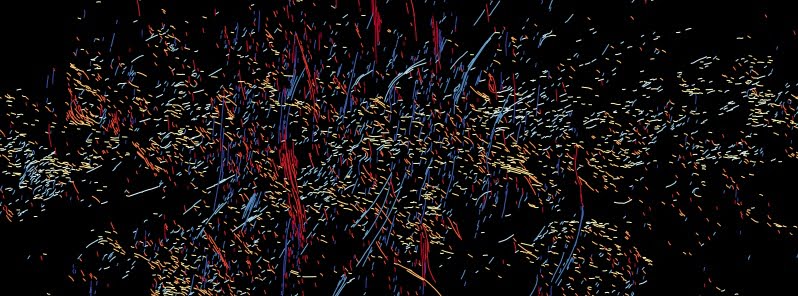A surprising discovery at the heart of the Milky Way galaxy

An international research team has unveiled a surprising discovery at the heart of the Milky Way galaxy.
Under the leadership of Northwestern University’s Farhad Yusef-Zadeh, the scientists discovered a new type of filament near Sagittarius A*, our galaxy’s central supermassive black hole. This marks a significant departure from the vertical filaments previously known to science.
These novel filaments are noticeably shorter than their vertical counterparts and are oriented horizontally or radially, akin to spokes on a wheel. Their location and orientation make them seem like an extension of the black hole. “It was a surprise to suddenly find a new population of structures that seem to be pointing in the direction of the black hole,” Yusef-Zadeh, a professor of physics and astronomy at Northwestern’s Weinberg College of Arts and Sciences and a member of CIERA, said.
The study, published in The Astrophysical Journal Letters on June 2, unveils these filaments and attempts to provide plausible explanations for their existence. Despite sharing similarities, Yusef-Zadeh believes the horizontal and vertical filaments likely have different origins.
While vertical filaments can be seen sweeping through the galaxy and reaching heights up to 150 light-years, the horizontal filaments more resemble the dots and dashes of Morse code, punctuating only one side of Sagittarius A*. “We think they must have originated with some kind of outflow from an activity that happened a few million years ago,” explained Yusef-Zadeh.
This discovery is the latest in a series of contributions from Yusef-Zadeh, who has been studying the center of our galaxy, located 25 000 light-years away, for four decades. After first discovering the vertical filaments in 1984, Yusef-Zadeh and his collaborators have since uncovered more cosmic phenomena, such as gigantic radio-emitting bubbles near Sagittarius A* and nearly 1 000 vertical filaments appearing in pairs and clusters.
These revelations have been made possible due to advancements in radio astronomy technology, especially the South African Radio Astronomy Observatory’s (SARAO) MeerKAT telescope. To identify the filaments, Yusef-Zadeh’s team used a technique to filter out the background noise from MeerKAT images, thereby isolating the filaments from surrounding structures.
The newfound filaments differ from their vertical counterparts in several ways, such as their emission of thermal radiation, acceleration of thermal material in a molecular cloud, and their lesser count. Also, the vertical filaments can measure up to 150 light-years high, dwarfing the 5 to 10 light-year length of the horizontal ones.
The discovery has raised new questions about the orientation of the accretion disk and the jet-driven outflow from Sagittarius A*, but Yusef-Zadeh’s quest to decipher the mysteries of our galaxy continues. “Our work is never complete. We always need to make new observations and continually challenge our ideas and tighten up our analysis,” he concluded.
References:
1 Mysterious dashes revealed in Milky Way’s center – Northwestern University – June 2, 2023
2 The Population of the Galactic Center Filaments: Position Angle Distribution Reveals a Degree-scale Collimated Outflow from Sgr A* along the Galactic Plane – Yusef Zadeh et al. – The Astrophysical Journal Letters – June 2, 2023 – DOI 10.3847/2041-8213/acd54b – OPEN ACCESS
Featured image: MeerKAT image of the galactic center with color-coded position angles of all filaments. Credit: Northwestern University

Commenting rules and guidelines
We value the thoughts and opinions of our readers and welcome healthy discussions on our website. In order to maintain a respectful and positive community, we ask that all commenters follow these rules.